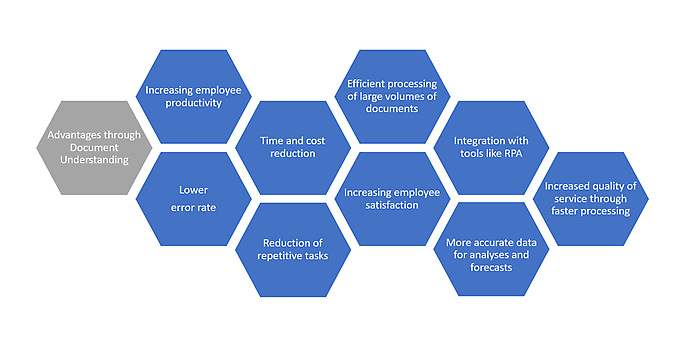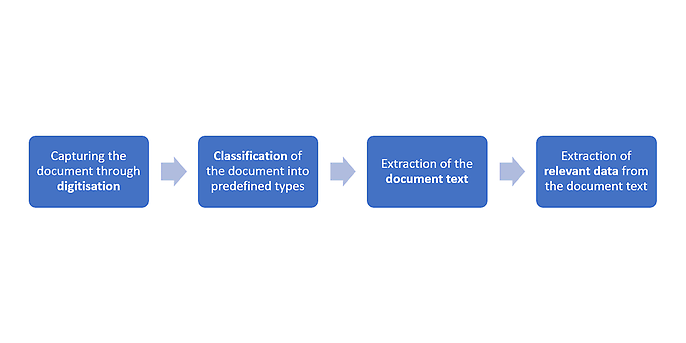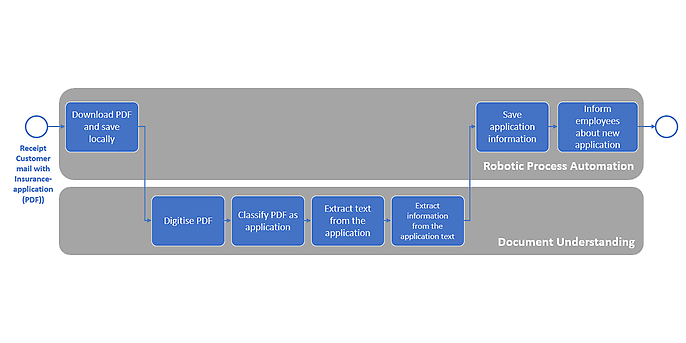9. October 2023 By Leonie Prümm
Document Understanding: the smart way to process information
Vast amounts of information and documents are generated in today’s digital world. Being able to process this information quickly and efficiently is vital for business success. Things that are easy for us as humans are often extremely difficult for robots. And the same could be said the other way around. While we can easily understand and classify a wide variety of documents, we find it difficult to work through thousands of forms. We lose focus, and mistakes creep in. This is where Document Understanding comes in, which is a process that can be used to categorise and analyse various documents such as contracts, invoices and forms as well as extract relevant information from them. Document Understanding allows you to complement document-based processes that are already partially automated with intelligent decision-making. Further process steps can in turn be automated that were previously done by hand and took a lot of time to complete. In addition, a database is created that can be used to perform analyses and generate forecasts.

Figure 1: Advantages offered by Document Understanding
What is Document Understanding?
Document Understanding, often referred to as Document Processing or Intelligent Document Processing, is a technology that enables computers to understand and extract information from documents. This is made possible through the use of concepts from the fields of artificial intelligence (AI) and machine learning, including computer vision or natural language processing (NLP). To understand the content and context of a document, it is essential to use a combination of technologies. Structured (such as a standardised form), semi-structured (such as a train ticket) and unstructured (such as a blog post) documents can all be processed. In addition to digitally generated (native) documents, scanned documents can be analysed, too.
The Document Understanding process begins when the document is scanned, at which time it is digitalised and converted into a machine-readable format. This is followed by automatic classification of the document to identify the type of document and its contents if there is more than one type of document. Next, text recognition technologies are used to extract and understand the text. In the final step, the information is extracted. Relevant information such as names, dates, amounts and other details is identified and stored in structured formats, as you can see in the figure below.

Figure 2: Example of information extraction
How can Document Understanding be deployed?
Document Understanding can be integrated into robotic process automation (RPA) using tools such as UiPath. Software robots that act in a highly rule-based manner are augmented to include intelligent decision-making options. The robot generates the data, which is used as the basis for making decisions. For example, a software robot can be used to process customer e-mails (see Figure 3). Here, a customer sends an e-mail with a scanned application for health insurance in PDF format. The robot processes the e-mail and saves the PDF file in the designated folder. Without Document Understanding, someone would have to intervene at this point to read and interpret the file as well as transfer the relevant data to the corresponding software. With it, however, a robot can perform this task. It digitises the scanned PDF document, classifies it as an application form and extracts the text. Customer data such as their name, the start date and insurance type are then extracted from the text and saved. After the application has been recorded, a human employee can now be called in to check the application. In the next step, the employee can assess whether the application is plausible and where certain points are ambiguous or unclear.

Figure 3: How customer e-mails are processed by a software robot
What changes does Document Understanding bring with it?
Many business processes today are still document-heavy. These documents are often only available in paper form and have to be laboriously typed out by hand and entered into existing systems. Humans are not made for such activities. We often do not enjoy them and cannot to perform them for an extended period of time without losing our focus and making mistakes. Document Understanding will fully automate document-based processes in the future, so that humans do not need to take any action except in rare cases.
For employees, this means that they will in the future be able to devote their time to creative, communication-related or complex tasks instead of having to do dull and repetitive work. In terms of robotic process automation, this means that robots are evolving away from rule-based action to smart decision-making. In combination with RPA, Document Understanding will expand the range of processes that can be automated, playing its part in achieving the RPA goal of automating high-volume, repetitive processes. All in all, Document Understanding will play a vital role in managing the information overload and helping companies make informed decisions. It is an exciting step towards smarter information processing that will permanently change the way companies work.
You can find more exciting topics from the adesso world in our blog articles published so far.

